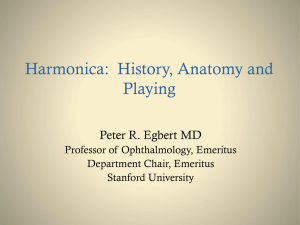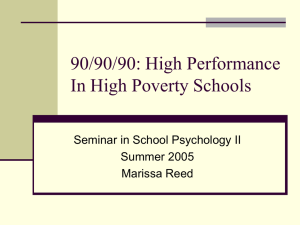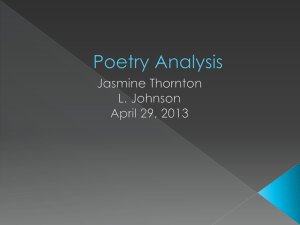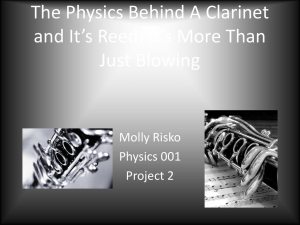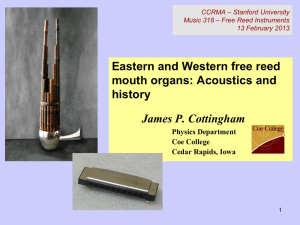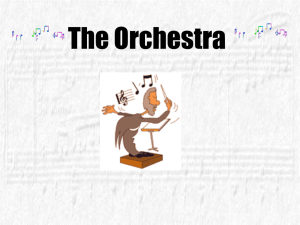FREE REEDS vs BEATING REEDS
advertisement
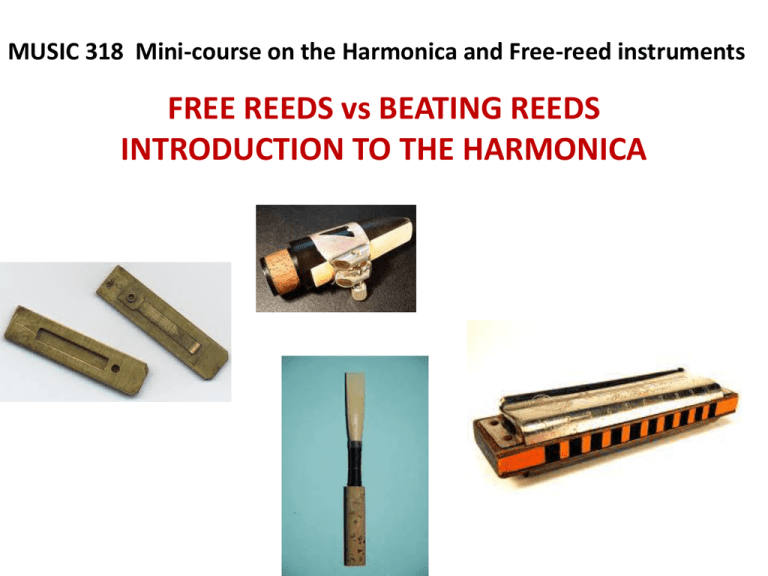
MUSIC 318 Mini-course on the Harmonica and Free-reed instruments FREE REEDS vs BEATING REEDS INTRODUCTION TO THE HARMONICA VIBRATING FLOW-CONTROL DEVICES (REEDS) THE MOTION OF A REED VALVE IS CONTROLLED BY THE PRESSURE DIFFERENCE ACROSS IT, AND THE FREQUENCY WITH WHICH IT VIBRATES IS CONTROLLED PARTLY BY ITS OWN NATURAL FREQUENCY AND PARTLY BY THE RESONANCES OF THE INSTRUMENT AIR COLUMN TO WHICH IT IS CONNECTED. TYPICAL REED CONFIGURATIONS (a) CLARINET OR SAXOPHONE (b) OBOE OR BASSOON (c) ORGAN REED PIPES (d) BRASS-INSTRUMENT PLAYER’S LIPS PRESSURE-CONTROLLED REED VALVES Helmholtz used the terms “inward-striking reeds” and “outward striking reeds” to describe reed valves in wind instruments. Fletcher has extended that to include a third type (sidewise striking) as well PRESSURE-CONTROLLED VALVES CAN BE CLASSIFIED AS: INWARD STRIKING (-,+), OUTWARD STRIKING (+,-) OR SIDEWAYS STRIKING (+,+) [-,+] means excess pressure at outlet opens the valve; [+,-] means excess pressure at inlet opens it. [+,+} is a sidewise opening valve, such as the human vocal folds. GENERATOR BEHAVIOR AT PLAYING FREQUENCY BEATING REEDS IN WOODWIND INSTRUMENTS ACT AS [-,+] VALVES WHICH ARE BLOWN SHUT. THEY GENERALLY PLAY BELOW THE NATURAL FREQUENCY OF THE REED IN ORGAN REED PIPES, THE [-,+] VALVE PLAYS SLIGHTLY BELOW THE NATURAL FREQUENCY OF THE REED THE LIPS OF A BRASS PLAYER ACT AS [+,-] VALVES. WHICH VIBRATE ABOVE THE NATURAL FREQUENCY (see Chapter 13 in Fletcher and Rossing (1998) FREE REEDS (a) (b) (c) (d) An idealized free reed, consisting of a curved reed that passes through an aperture A typical instrument reed A pair of reeds of opposite geometry, closely coupled as in a harmonica Static flow characteristic of the idealized reed in (a) (from Fletcher and Rossing, 1998) VIBRATIONAL MODES OF A BAR A REED CAN VIBRATE IN MANY DIFFERENT MODES, BUT THE FREQUENCIES ARE SO WIDELY SEPARATED THAT ONLY THE FUNDAMENTAL MODE IS GENERALLY EXCITED REED COUPLED TO A RESONATOR IN WIND INSTRUMENTS, THE VIBRATING REED VALVE IS STRONGLY COUPLED TO A RESONATOR (THE INSTRUMENT), SO THAT THE OPENING AND CLOSING OF THE REED (OR LIP) VALVE IS LARGELY DETERMINED BY FEEDBACK FROM THE RESONATOR. IN AN ORGAN REED PIPE, THE REED IS TUNED (BY MOVING A STIFF WIRE ALONG ITS LENGTH) SO THAT IT COUPLES STRONGLY AND SMOOTHLY TO ONE OF THE MODES OF THE PIPE RESONATOR. FREE REED COUPLED TO A RESONATOR The influence of the resonator length on an organ pipe with a free reed. HARMONICA REEDS A pair of reeds of opposite geometry closely coupled in a harmonica Acoustic conductance of a coupled pair of harmonica reeds when the resonance frequency of the closing reed is higher than the opening reed Acoustic conductance of a coupled pair of harmonica reeds when the resonance frequency of the opening reed is higher than the closing reed HARMONICA REEDS A pair of reeds of opposite geometry closely coupled in a harmonica When the harmonica is blown, the sounding threshold pressure of the [-,+] reed is much lower than that of the[+,-} reed, so it is the [-,+[ reed that sounds, the other reed sounding when the harmonica is played by suction, partly because of acoustic impedance loading by the flow through the reeds and partly because the mean center of vibration of the [+,-] reed leaves a much more open channel than the [-,+] reed. When the reed opens, air escapes through the reed slot and it releases a puff of air. When it enters the reed slot it does not, so as it opens and closes it sends regular puffs of air (sound waves). The only notes that can be bent are those for which the other note on the same channel has a lower pitch than the note being played (Johnston, 1987]. HARMONICA TEN-HOLE DIATONIC HARMONICA NOTES OBTAINED BY BLOWING OR DRAWING AT THE TEN HOLES CHROMATIC HARMONICA The chromatic harmonica is a type of harmonica that uses a button-activated sliding bar to redirect air from the hole in the mouthpiece to the selected reed-plate desired. When the button is not pressed, an altered diatonic major scale of the key of the harmonica is available, while depressing the button accesses the same scale a semi-tone higher in each hole. Thus, the instrument is capable of playing the 12 notes of the Western chromatic scale. Chromatic harmonicas are usually 12, 14 or 16 holes long. The 12-hole chromatic is available in 12 keys, but because the entire chromatic scale is available by definition, most professionals stick with the key of C—which is perhaps easier to remember, since slide in will automatically be the sharps of the associated note. HARMONICA REEDS COUPLED TO A RESONATOR IN A HARMONICA, THE TWO REEDS ARE COUPLED THROUGH THE COMB CAVITY, WHICH IN TURN COUPLES TO THE VOCAL TRACT OF THE PLAYER. NO RIGOROUS THEORY HAS YET BEEN FORMULATED, BUT A NUMBER OF EXPERIMENTS HAVE LED TO A REASONABLY GOOD UNDERSTANDING OF THE COUPLING PHENOMENON. HARMONICA REEDS COUPLED TO A RESONATOR Johnston (1987) studied a harmonic blown mechanically through a cylindrical resonator which simulated the vocal tract. HARMONICA REEDS COUPLED TO A RESONATOR Brock and Cottingham (2011) blew a harmonica through a small box resonator, and observed how the frequency changed with pressure with the draw reed taped and with it held in place with putty but still open to allow air to escape. RESEARCH ON HARMONICA ACOUSTICS ● H. Bahnson, J. Antaki, Q. Beery, University of Pittsburgh School of Medicine Their paper in J.Acoust. Soc. Am. (1998) is a MUST READ ● James Cottingham and students at Coe College An outstanding research program on free-reed instruments. Cottingham organized a special session on Acoustics of Mouth Organs at a meeting of the Acoustical Society of America in October 2011 ● Robert Johnston wrote early papers (1986, 1987) on pitch bending by means of the vocal tract ● Peter Egbert has organized a group at Stanford which is using MRI to study the vocal tract during pitch bending. The group includes Lewis Shin and Andrew Holbrook (Medical School), Thomas Rossing and John Granzow (CCRMA), and David Barrett (professional harmonica player and teacher). ● Joe Wolfe, John Smith, and colleagues at the University of New South Wales have extensively studied the vocal tract and its role in speech, singing, and playing wind instruments Music 318-1 Acoustics of Speech and Singing: Schedule 2013 F Jan. 11: Speech Production, Formants and Articulation (Chapter 15) M Jan. 14: Vocal Fold Vibrations as Sound Source; Experiments with Vocal Tract Synthesis; Rhythm, Prosody, Tone, Language (Chapter 15); Experiments with Vocal Tract Synthesis (Chapter 15) W Jan. 16: Speech Analysis, Recognition, and Synthesis (Chapter 16) W Jan.23: Singing (Chapter 17) F Jan . 25: Solo Singing, Choir Singing, Harmonic Singing, Pop Singing M Jan. 28: Voce Vista; Electroglottograph, Closed quotient (Miller, Chaps 2, 5) W Jan 30 or F Feb. 1: Nonlinear Source-Filter Coupling in Speech and Singing Summary, exam or project evaluation Music 318-2 Acoustics of the Harmonica: Tentative schedule 2013 M Feb 4 Introduction to the harmonica; free reeds and beating reeds---TDR W Feb 6 The harmonica: History, Anatomy, and How to Play it—Peter Egbert M Feb 11 TBA—TDR W Feb 13 Free-reed instruments---James Cottingham Thurs, Feb. 14 Colloquium 5:15--- James Cottingham F Feb 15 or M Feb 18 Cottingham (Monday is President’s Day) W Feb 20 TBA F Feb 22 10:00 Pitch bending and blues playing---David Barrett W Feb 27 Colloquium 5:15---MRI Measurements of the Vocal Tract, Peter Egbert
